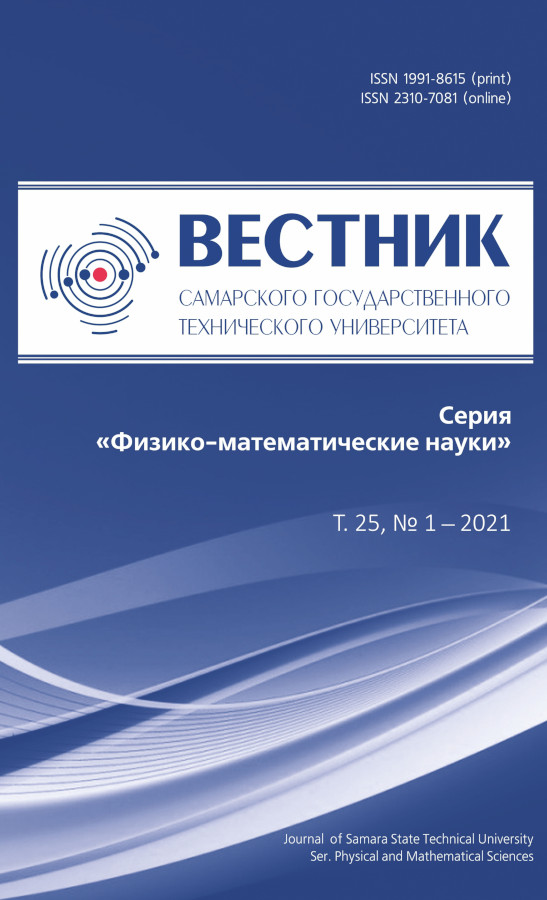Healing of cracks in plates by strong electromagnetic field
- Authors: Kukudzhanov K.V.1, Levitin A.L.1, Ugurchiev U.K.2
-
Affiliations:
- Ishlinsky Institite for Problems in Mechanics, Russian Academy of Sciences
- Mechanical Engineering Research Institute of the Russian Academy of Sciences
- Issue: Vol 25, No 1 (2021)
- Pages: 193-202
- Section: Short Communications
- URL: https://journals.eco-vector.com/1991-8615/article/view/61608
- DOI: https://doi.org/10.14498/vsgtu1831
- ID: 61608
Cite item
Full Text
Abstract
The problem of a pulsed high-energy electromagnetic field action on an edge crack in a thin plate, reproducing the pioneering experiment of Soviet scientists on the destruction of the crack tip by a strong electromagnetic field, is considered. The numerical simulation is based on the proposed electrothermomechanical model of a short-pulse high-energy electromagnetic field (HEMF) action on a material with a crack. The model takes the phase transformations (melting and evaporation) of the material occurring in the vicinity of defects and the corresponding changes in the rheology of the material in the areas of these transformations into account, as well as the possibility of electric current flowing between the free surfaces of the crack (breakdown due to electron emission). All physical and mechanical properties of the material are considered temperature-dependent. The model equations are coupled and solved together on a moving finite element grid using the arbitrary Euler–Lagrangian method. The processes of localization of the current density and temperature fields, phase transformations (melting and evaporation) at the crack tip, autoelectronic and thermoelectronic emissions between free crack surfaces, and the effect of these processes on crack healing are investigated. The simulation results are compared with the available experimental data on the pulse field action on the edge crack in the plate. The average metal heating rate, temperature gradients and time forming of the crater obtained in the vicinity of the crack tip are in good quantitative agreement with the experimental data. Away from the crack, as well as on the crack sides away from the tip, the temperature rises slightly. The process of modeling the electromagnetic field action, similar to the experiment, was accompanied by melting at the crack tip, as well as metal evaporation. Thus, under the considered current action, a crater is formed at the crack tip, which prevents the further spread of the crack, leading to its healing. It was not possible to obtain similar results using the previously proposed models.
About the authors
Konstantin V. Kukudzhanov
Ishlinsky Institite for Problems in Mechanics, Russian Academy of Sciences
Email: kconstantin@mail.ru
ORCID iD: 0000-0001-9060-2838
SPIN-code: 1402-1901
http://www.mathnet.ru/rus/person169447
Cand. Phys. & Math. Sci.; Senior Researcher
101–1, pr. Vernadskogo, Moscow, 119526, Russian FederationAlexander L. Levitin
Ishlinsky Institite for Problems in Mechanics, Russian Academy of Sciences
Email: alex_lev@ipmnet.ru
ORCID iD: 0000-0003-2077-8808
SPIN-code: 5367-1314
ResearcherId: J-9511-2013
http://www.mathnet.ru/rus/person30893
Leading Programmer
101–1, pr. Vernadskogo, Moscow, 119526, Russian FederationUmar Kh. Ugurchiev
Mechanical Engineering Research Institute of the Russian Academy of Sciences
Author for correspondence.
Email: umar77@bk.ru
ORCID iD: 0000-0003-2072-6354
SPIN-code: 1828-7089
http://www.mathnet.ru/rus/person169448
Researcher
4, M. Khariton’evskii per., Moscow, 101990, Russian FederationReferences
- Finkel V. M., Golovin Yu. I., Sletkov A. A. Disintegration of a crack tip with a strong electromagnetic field, Sov. Phys. Dokl., 1977, vol. 22, pp. 683–685.
- Finkel V. M., Golovin Yu. I., Sletkov A. A. Possibility of braking rapid cracks by pulses of current, Sov. Phys. Dokl., 1976, vol. 21, no. 4, pp. 216–218.
- Kudryavtsev B. A., Parton V. Z., Rubinskii B. D. Electromagnetic and thermoelastic fields in a conducting plate with a cut of finite length, Mech. Solids, 1982, vol. 17, no. 1, pp. 110–118.
- Parton V. Z., Kudryavtsev B. A., Rubinskii B. D. Crack propagation under the action of an electromagnetic field, Dokl. Akad. Nauk SSSR, 1980, vol. 250, no. 5, pp. 1096–1100 (In Russian).
- Cai G. X., Yuan F. G. Stresses around the crack tip due to electric current and self-induced magnetic field, Adv. Eng. Software, 1998, vol. 29, no. 3–6, pp. 297–306. https://doi.org/10.1016/S0965-9978(97)00078-1.
- Cai G. X., Yuan F. G. Electric current-induced stresses at the crack tip in conductors, Int. J. Fract., 1999, vol. 96, no. 3, pp. 279–301. https://doi.org/10.1023/A:1018670829822.
- Liu T. J. C. Effects of temperature-dependent material properties on stress and temperature in cracked metal plate under electric current load, World Academy of Science, Engineering and Technology. Int. J. Mechanical and Mechatronics Eng., 2010, vol. 4, no. 5, pp. 474–479. https://doi.org/10.5281/zenodo.1072134.
- Yu J., Zhang H., Deng D., Hao S., Iqbal A. Numerical calculation and experimental research on crack arrest by detour effect and joule heating of high pulsed current in remanufacturing, Chin. J. Mech. Eng., 2014, vol. 27, no. 4, pp. 745–753. https://doi.org/10.3901/CJME.2014.0414.075.
- Gallo F., Satapathy S., Ravi-Chandar K. Melting and crack growth in electrical conductors subjected to short-duration current pulses, Int. J. Fract., 2011, vol. 167, no. 2, pp. 183–193. https://doi.org/10.1007/s10704-010-9543-0.
- Ovchinnikov I.V. Influence of electric current on the plasticity of metals, PhD Thesis. Moscow, 1989, 123 pp. (In Russian)
- Kukudzhanov K. V., Levitin A. L. Deformation processes of elastoplastic material with defects under electrodynamic loading, PNRPU Mechanics Bulletin, 2015, no. 1, pp. 106–120 (In Russian). https://doi.org/10.15593/perm.mech/2015.1.07.
- Kukudzhanov K.V. Modeling the treatment of high-energy pulsed electromagnetic field of the micro-cracks in a polycrystalline metal, PNRPU Mechanics Bulletin, 2015, no. 4, pp. 138–158 (In Russian). https://doi.org/10.15593/perm.mech/2015.4.09.
- Kukudzhanov K. V., Levitin A. L. Modeling the healing of microcracks in metal stimulated by a pulsed high-energy electromagnetic field. Part I, Int. J. Nanomech. Sci. Tech., 2015, vol. 6, no. 3, pp. 233–249. https://doi.org/10.1615/NanomechanicsSciTechnolIntJ.v6.i3.60.
- Sivukhin D. V. Termodinamika i molekulyarnaya fizika [Thermodynamics and Molecular Physics]. Moscow, Fizmatlit, 2014, 544 pp. (In Russian)
- Pikunov M. V. Plavka metallov. Kristallizatsiia splavov. Zatverdevanie otlivok [Metal Smelting. Alloy Crystallization. The Solidification of Castings]. Moscow, MISiS, 1997, 374 pp. (In Russian)
- Pikunov M. V. Metallurgiia rasplavov. Kurs lektsii [Metallurgy of the Melts. A Course of Lectures]. Moscow, MISiS, 2005, 286 pp. (In Russian)
Supplementary files







